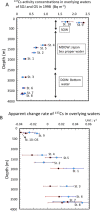Temporal changes of 137Cs concentrations in the Far Eastern Seas: partitioning of 137Cs between overlying waters and sediments
- PMID: 38151506
- PMCID: PMC10752905
- DOI: 10.1038/s41598-023-49083-4
Temporal changes of 137Cs concentrations in the Far Eastern Seas: partitioning of 137Cs between overlying waters and sediments
Abstract
Deep-ocean sediments, similarly to seawater, are important reservoirs of 137Cs, an anthropogenic radionuclide with a relatively long half-live found in the Earth system. To better understand the geochemical behaviour of 137Cs in the ocean, we examined the temporal changes of 137Cs activity concentrations in the overlying waters and in sediments from the Far Eastern Seas (Sea of Japan, SOJ, and Okhotsk Sea, OS) during the period of 1998-2021. The 137Cs activity levels showed exponential changes during the observed period. The decay-corrected change rates of 137Cs in deep waters of SOJ exhibited a slow increase, while 137Cs levels in seawater and sediment in OS decreased gradually. This reflects a topographical difference, as SOJ is a semi-closed sea, whereas OS receives continuously inflow of subarctic waters. It was confirmed that 137Cs released after the Fukushima Dai-ichi Nuclear Power Plant accident was rapidly transported into the deep waters of the SOJ. To elucidate the transfer processes of 137Cs from seawater to sediment, we discussed the temporal changes of the partition coefficients (Kd) of 137Cs between the overlying water and the surface sediment. In shallow areas (< 1500 m water depth), Kd values were almost constant within the sampling periods, although the temporal changes in the Kd values occurred in deeper waters (> 2500 m depth). The Kd values increased with increasing depth, which may reflect a pressure effect as a possible mechanism. These findings suggest that chemical processes may be important factors controlling the transport of 137Cs between seawater and sediment, although more complicated phenomena occurred in deep waters and sediments of the SOJ (> 3000 m depth).
© 2023. The Author(s).
Conflict of interest statement
The authors declare no competing interests.
Figures









Similar articles
-
137Cs and 90Sr in surface waters of the Sea of Japan: Variations and the Fukushima Dai-ichi Nuclear Power Plant accident impact.Mar Pollut Bull. 2019 Sep;146:645-652. doi: 10.1016/j.marpolbul.2019.07.024. Epub 2019 Jul 17. Mar Pollut Bull. 2019. PMID: 31426204
-
Temporal variability of plutonium in surface waters of the Sea of Japan.J Environ Radioact. 2022 Jul;248:106890. doi: 10.1016/j.jenvrad.2022.106890. Epub 2022 Apr 25. J Environ Radioact. 2022. PMID: 35477137
-
Shipboard determination of radiocesium in seawater after the Fukushima accident: results from the 2011-2012 Russian expeditions to the Sea of Japan and western North Pacific Ocean.J Environ Radioact. 2014 Sep;135:13-24. doi: 10.1016/j.jenvrad.2014.03.016. Epub 2014 Apr 14. J Environ Radioact. 2014. PMID: 24727550
-
Spatiotemporal distribution of 137Cs in the sea surrounding Japanese Islands in the decades before the disaster at the Fukushima Daiichi Nuclear Power Plant in 2011.Sci Total Environ. 2013 Oct 1;463-464:913-21. doi: 10.1016/j.scitotenv.2013.06.031. Epub 2013 Jul 17. Sci Total Environ. 2013. PMID: 23872184
-
Radiocesium in Japan Sea associated with sinking particles from Fukushima Dai-ichi Nuclear Power Plant accident.J Environ Radioact. 2020 Oct;222:106348. doi: 10.1016/j.jenvrad.2020.106348. Epub 2020 Jul 10. J Environ Radioact. 2020. PMID: 32892904
References
-
- UNSCEAR. Sources and Effects of Ionizing Radiation. (United Nations, 2000).
-
- Nagaya Y, Nakamura K. Artificial radionuclides in the western Northwest Pacific (II):137Cs and 239,240Pu inventories in water and sediment columns observed from 1980 to 1986. J. Oceanogr. Soc. Japan. 1987;43:345–355. doi: 10.1007/BF02109287. - DOI
-
- Nagaya, Y., Nakamura, K. Distributions and mass-balance of 239,240Pu and 137Cs in the Northern North Pacific. in Deep Ocean Circulation: Physical and Chemical Aspects (Ed. T. Teramoto). Elsevier Oceanography Series, 59, 157–168. (Elsevier, 1993).
-
- Moon, et al. Accumulation of anthropogenic and natural radionuclides in bottom sediments of the Northwest Pacific Ocean. Deep-Sea Res. 2003;II(50):2649–2673.
LinkOut - more resources
Full Text Sources

